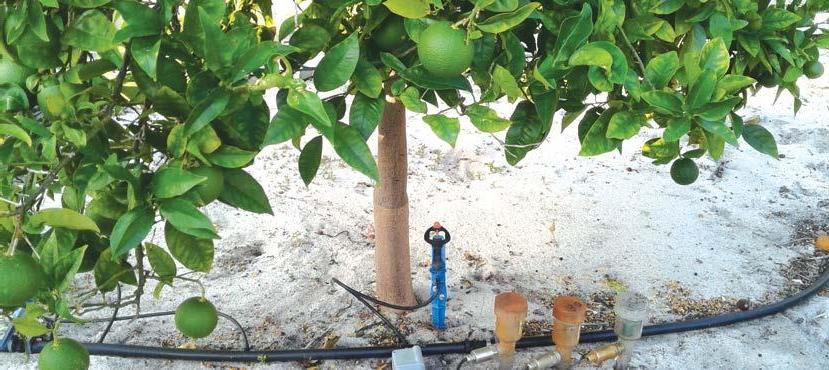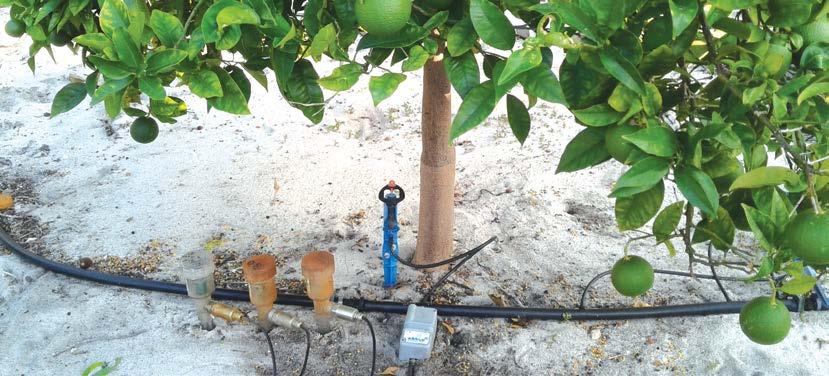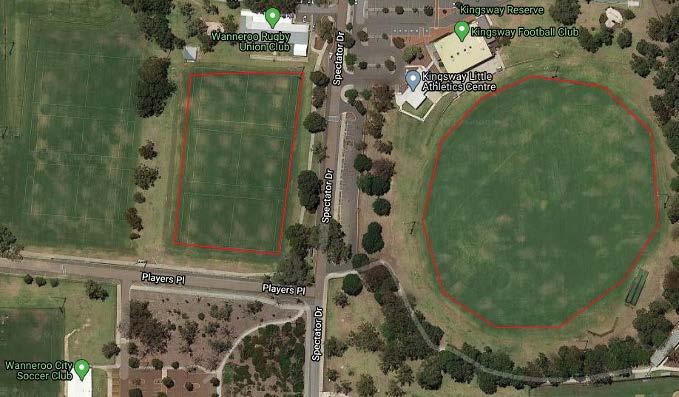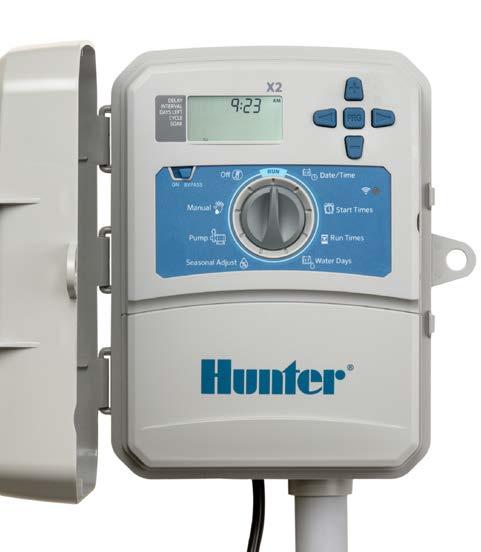
7 minute read
Improving irrigation practices in the West Gingin and North Wanneroo areas
By Neil Lantzke
In 2018 the National Landcare Program, through its Smart Farms Small Grants program with the City of Wanneroo, funded Perth NRM to work with a range of irrigators in the North Wanneroo and West Gingin areas to improve water use efficiency.
Advertisement
The irrigators involved were: • Eight fruit growers (avocado, mango and citrus) • Four turf farmers • One local government authority (City of Wanneroo)
The uniformity of the irrigation system was measured and soil moisture sensors were installed on each of the properties. The project officer worked with the growers to help them use soil moisture and the evapotranspiration (ETo) data to more accurately schedule irrigation.
Fruit growers
Surveys of water use by irrigators on the sandy soils of the Swan Coastal Plain have shown that many can improve their irrigation practices. Soil water monitoring is a tool that can assist fruit growers to decide when to irrigate and how much water to apply. Adoption of soil water monitoring by fruit growers on the sands of the Swan Coastal Plain in Western Australia has not been widespread.
The aims of this component of the project were to: • Determine if soil water monitoring is a useful tool that fruit growers will adopt Document the limitations of different soil water monitoring equipment on coarse sands Define critical soil water levels or ‘refill points’ for different fruit species on coarse sands
Capacitance probes and tensiometers were installed adjacent to each other on the eight properties. The equipment was connected to loggers and the growers could view the soil water graphs via the internet. An irrigation agronomist assisted growers with the installation of the sensors and interpretation of the soil water graphs.
It was found that tensiometers are better suited than capacitance probes in determining refill points in the coarse sands. Tensiometer readings plummet as the soil dries which makes it easier to determine the refill point, while soil moisture decreases slowly as the soil dries out making it more difficult to determine the refill point when using capacitance probes.
The capacitance probes were however a more robust piece of equipment that required little or no maintenance. If the soil was allowed to dry out (approximately >40 kPa) this caused air to enter the tensiometers which affected the readings. This required the grower to manually remove the air bubbles from the tensiometer body. The tensiometers functioned well when the soil was kept at the desirable water content. A document titled ‘Using soil water sensors to schedule irrigation of fruit trees on sandy soils’ was written (available to download at https://drive. google.com/uc?export=download&id= 15bOKhH0HrM5O6pFxeQXZiedwjfY NZIyk ). The sandy soils of the Swan Coastal Plain have a very low water holding capacity and the irrigation management is quite different to that on sandy soils that are used elsewhere for horticulture. This document contains guidelines for the installation of soil moisture sensors on sands, information on how to interpret the results and discussion on the benefits and limitations of different soil water monitoring equipment. Guidelines for soil water monitoring and critical soil tensions at which irrigation should be applied are presented for citrus, mangoes and avocados when grown on these coarse sands.
The study showed that in some cases growers were applying excessive amounts of water while in other cases growers were under irrigating. Prior to using soil water sensors most growers were not adequately adjusting their irrigation to account for days with significantly higher or lower evapotranspiration. Most of the growers did not have a documented irrigation plan that was based on long term climatic data and crop factors.
Over the first six months of the project the growers gained a better understanding of how to interpret trends in the data and the benefits and

Figure 1. Tensiometers with pressure transducers that are connected to a logger

Figure 2. Soil moisture graph showing a period of over watering
limitations of soil water sensing. The majority of the growers involved in the study now view the soil water data regularly and use the information to help schedule their irrigations. The overall response to the study has been positive and some of the growers have bought additional soil water sensors and installed them in other irrigation blocks.
Assessment of irrigation at Kingsway Reserve in the City of Wanneroo
Perth NRM worked with the City of Wanneroo over the 2019/20 irrigation season to improve the efficiency of irrigation on the football oval at the Kingsway Sporting Complex. Watering at Kingsway Sporting Complex is based on evapotranspiration (ET) from an onsite weather station. The daily ET at 6 pm is used to automatically update nightly runtimes on individual stations. Active sports fields are irrigated at 70% of daily ET. Each station is evaluated on a daily basis by staff and manual adjustments can be made to the run times if required. This approach has enabled the City of Wanneroo to accurately apply irrigation based on the climatic conditions. measured by using a grid of catch cans. Figure 3 shows the results from one of the sites. The black cylinders show the location of the sprinklers (Hunter I25, blue nozzles, at 16.5 m x 16. 5 m spacing and 400 kPa nozzle pressure).
A moderate easterly wind (11 km/ hour) was present during the test, which in Figure 3 is coming from the top of the page. The distribution uniformity of the irrigation pattern was 70% which is below acceptable standards. The application rate was low in the area immediately downwind of each sprinkler (see Figure 3).

Figure 3. Application uniformity of the sprinklers in a section of Kingsway Oval.
Six sets of soil moisture sensors were installed below the turf to determine the accuracy of the sensors and to assess the usefulness of the equipment in assisting with scheduling of irrigation events. The equipment accurately measured soil moisture.
The biggest limitation to using soil moisture sensors to assist with irrigation scheduling was the poor application uniformity of the irrigation.
The sensors showed that the soil moisture below much of the sprinkler wetting pattern was above the critical moisture content indicating that the irrigation could have been reduced. However, within 10 metres of the sensors, in the locations where the sprinkler application rate was lower, the soil was dry and the condition of the turf was poor.
In an attempt to improve the sprinkler uniformity, the sprinkler nozzles and operating pressure were altered and the uniformity was re-tested. These changes made only slight improvements to the uniformity of the irrigation.
A large percentage of the sports turf in the Perth Metropolitan area shows dry patches in the summer months as a result of poor irrigation uniformity.

This poor uniformity is exacerbated under windy conditions that are common on the Swan Coastal Plain. To significantly improve irrigation uniformity, it is likely that on many areas, sprinklers and laterals will need to be installed at closer spacings than what are currently used.
Guidelines for the design of turf irrigation systems that have an acceptable distribution uniformity in windy conditions should be developed and this information needs to be extended to industry.
An economic assessment should be conducted to compare the total capital and operating cost of installing a more uniform irrigation system, with examples of typical existing irrigation designs. The capital cost of installing a more uniform system will be higher however more even turf growth can be achieved with less water which is important with a planned reduction in water allocations.
Soil moisture sensors can be used to monitor the effectiveness of a weather based (ET) approach to irrigation scheduling– provided the irrigation system applies water with an acceptable uniformity.
Many thanks to turf consultant John Forrest who assisted with the turf component of the study.
ADD A WAND TO THE X2 ™ AND WATCH THE MAGIC.


UPGRADE X2 CONTROLLERS TO HYDRAWISE® MANAGEMENT with the simple plug-in WAND module. Hydrawise maximizes water savings with automatic daily schedule adjustments based on local, real-time weather data. A helpful setup wizard makes programming fast and easy. Then, manage irrigation from your smartphone, tablet, or the web. Presto change-o!
RESIDENTIAL & COMMERCIAL IRRIGATION | Built on Innovation ® Learn more. Visit https://hunter.direct/x2

